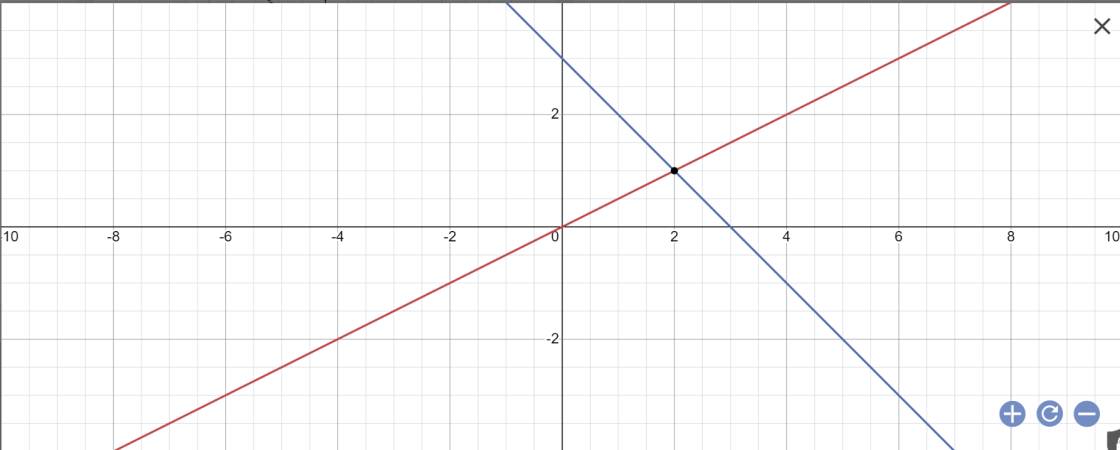Hãy nhập câu hỏi của bạn vào đây, nếu là tài khoản VIP, bạn sẽ được ưu tiên trả lời.

Câu 1:
a,Bạn tự vẽ
b,Phương trình hoành độ giao điểm của (d1) và (d2) là:
\(\(\(-2x+3=x-1\Rightarrow-3x=-4\Rightarrow x=\frac{4}{3}\)\)\)
\(\(\(\Rightarrow y=\frac{4}{3}-1=\frac{1}{3}\)\)\)
Vậy tọa độ giao điểm của (d1) và (d2) là \(\(\(\left(\frac{4}{3};\frac{1}{3}\right)\)\)\)
c,Đường thẳng (d3) có dạng: y = ax + b
Vì (d3) song song với (d1) \(\(\(\Rightarrow\hept{\begin{cases}a=a'\\b\ne b'\end{cases}}\Rightarrow\hept{\begin{cases}a=-2\\b\ne3\end{cases}}\)\)\)
Khi đó (d3) có dạng: y = -2x + b
Vì (d3) đi qua điểm A( -2 ; 1) nên \(\(\(\Rightarrow x=-2;y=1\)\)\)
Thay x = -2 ; y = 1 vào (d3) ta được:\(\(\(1=-2.\left(-2\right)+b\Rightarrow b=-3\)\)\)
Vậy (d3) có phương trình: y = -2x - 3
Câu 2:
\(A=\frac{a\sqrt{b}+b\sqrt{a}}{\sqrt{ab}}:\frac{1}{\sqrt{a}-\sqrt{b}}\left(a>0;b>0;a\ne b\right)\)(Đề chắc phải như này)
\(\(\(=\frac{\sqrt{ab}\left(\sqrt{a}+\sqrt{b}\right)}{\sqrt{ab}}.\frac{\sqrt{a}-\sqrt{b}}{1}\)\)\)
\(\(\(=\left(\sqrt{a}+\sqrt{b}\right)\left(\sqrt{a}-\sqrt{b}\right)\)\)\)
\(\(\(=\sqrt{a}^2-\sqrt{b}^2\)\)\)
\(\(\(=a-b\)\)\)

1. a) Để hàm số đồng biến thì m-1>0\(\Rightarrow\)m>1 b) Để hàm số nghịch biến m-1<0\(\Rightarrow\)m<1 2. a) Tự làm b) Xét phương trình hoành độ -2x+1=2x\(\Rightarrow\)x=1/4\(\Rightarrow\) y=1/2. Vậy giao điểm của d và d' có tọa độ (1/4; 1/2)
3 a)ĐKXĐ \(x\ge0\)\(x\ne1\)A=\(\frac{\sqrt{x}+1-\sqrt{x}+1-2\sqrt{x}}{2\left(\sqrt{x}-1\right)\left(\sqrt{x}+1\right)}\)=\(\frac{-2}{\sqrt{x}+1}\) b)Khi x= \(6-2\sqrt{5}\)thì A=\(\frac{-2}{\sqrt{\left(\sqrt{5}-1\right)^2}+1}\)=\(\frac{2}{\sqrt{5}}\)

a) Hàm số đã cho là y = 2x + b.
Vì đồ thị đi qua điểm A(1,5; 0) nên 0 = 2 . 1,5 + b. Suy ra b = -3.
Vậy hàm số đã cho là y = 2x - 3.
b) Hàm số đã cho là y = 3x + b.
Vì đồ thị đi qua điểm A(2; 2) nên 2 = 3 . 2 + b. Suy ra b = -4.
Vậy hàm số đã cho là y = 3x - 4.
c) Vì đồ thị của hàm số đã cho song song với đường thẳng y = √3x nên nó có hệ số góc là a = √3. Do đó hàm số đã cho là y = √3x + b.
Vì đồ thị đi qua điểm B(1; √3 + 5) nên √3 + 5 = √3 . 1 + b. Suy ra b = 5.
Vậy hàm số đã cho là y = √3x + 5.
Bài giải:
a) Hàm số đã cho là y = 2x + b.
Vì đồ thị đi qua điểm A(1,5; 0) nên 0 = 2 . 1,5 + b. Suy ra b = -3.
Vậy hàm số đã cho là y = 2x - 3.
b) Hàm số đã cho là y = 3x + b.
Vì đồ thị đi qua điểm A(2; 2) nên 2 = 3 . 2 + b. Suy ra b = -4.
Vậy hàm số đã cho là y = 3x - 4.
c) Vì đồ thị của hàm số đã cho song song với đường thẳng y = √3x nên nó có hệ số góc là a = √3. Do đó hàm số đã cho là y = √3x + b.
Vì đồ thị đi qua điểm B(1; √3 + 5) nên √3 + 5 = √3 . 1 + b. Suy ra b = 5.
Vậy hàm số đã cho là y = √3x + 5



Bài 3:
a:
b: Phương trình hoành độ giao điểm của (d1) và (d2) là:
\(\dfrac{1}{2}x=-x+3\)
=>\(\dfrac{1}{2}x+x=3\)
=>1,5x=3
=>x=2
Khi x=2 thì y=-x+3=-2+3=1
Vậy: (d1) cắt (d2) tại A(2;1)
c:
Đặt (d): y=ax+b(a<>0)
Vì (d)//(d2) nên a=-1 và b<>3
=>(d): y=-x+b
Thay x=4 vào (d1), ta được:
\(y=\dfrac{1}{2}\cdot4=2\)
Thay x=4 và y=2 vào (d), ta được:
b-4=2
=>b=6
Vậy: (d): y=-x+6
Bài 2:
a: ĐKXĐ: x>=2/3
\(\sqrt{3x-2}=5\)
=>\(3x-2=5^2=25\)
=>3x=25+2=27
=>x=27/3=9(nhận)
b: ĐKXĐ: \(x\in R\)
\(\sqrt{4x^2-4x+1}=1\)
=>\(\sqrt{\left(2x-1\right)^2}=1\)
=>|2x-1|=1
=>\(\left[{}\begin{matrix}2x-1=1\\2x-1=-1\end{matrix}\right.\Leftrightarrow\left[{}\begin{matrix}2x=2\\2x=0\end{matrix}\right.\)
=>\(\left[{}\begin{matrix}x=1\left(nhận\right)\\x=0\left(nhận\right)\end{matrix}\right.\)
Bài 1:
\(A=2\sqrt{5}-\sqrt{20}+3\sqrt{45}\)
\(=2\sqrt{5}-2\sqrt{5}+3\cdot3\sqrt{5}\)
\(=9\sqrt{5}\)
\(B=\sqrt{\left(2-\sqrt{3}\right)^2}+\sqrt{\left(2+\sqrt{3}\right)^2}\)
\(=\left|2-\sqrt{3}\right|+\left|2+\sqrt{3}\right|\)
\(=2-\sqrt{3}+2+\sqrt{3}=4\)